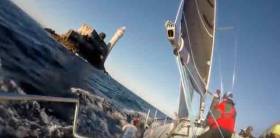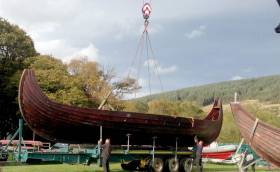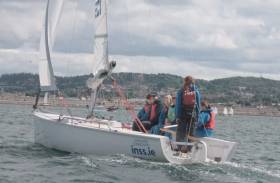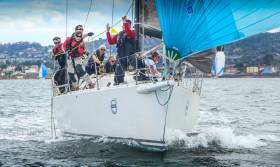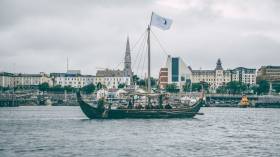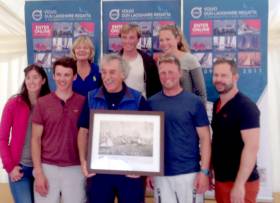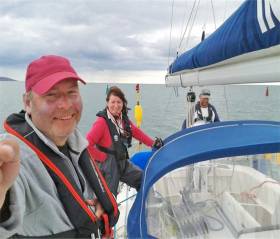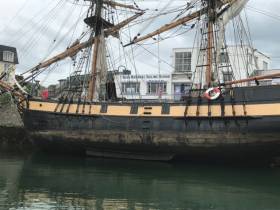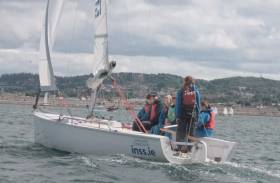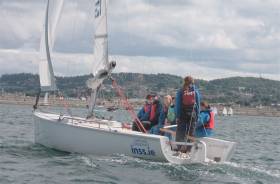Displaying items by tag: INSS
Irish National Sailing School Fastnet Race Video Recalls Epic Race
The Irish National Sailing School (INSS) on Dublin Bay have published a video showing their highlights from August's 2017 Rolex Fastnet Race on board the Dun Laoghaire School's J109 Jedi.
Skippered by Kenneth Rumball, Jedi (now for sale on Afloat.ie here) finished first in IRC 3B and won the Roger Justice Trophy, as Afloat.ie reported at the time here for the top placed sailing school yacht.
Listen in to Kenny and the crew onboard below:
Irish National Sailing School Viking Ship Plan for Dun Laoghaire Harbour
Go–ahead Irish Sailing School, the INSS, are planning to moor a 50–foot Viking Ship in front of their Dun Laoghaire Harbour premises at the West Pier in Dun Laoghaire.
In August, School Principal Kenneth Rumball co-ordinated a 'Battle of Dun Laoghaire Harbour' fought By 'Viking invaders'. It was a free and family–friendly event that featured battles, longboats and a Viking village that was a collaboration between Dun Laoghaire Harbour, actors from the Viking TV series and the INSS to celebrate the harbour's bicentenary.
As well as sailing instruction, the leading Irish sailing school also provides marine location services, including logistic work for the hit TV series 'Vikings', filmed in Wicklow.
The success of August's battle has led the school to develop plans to moor one of the longships in Dun Laoghaire's Coal Harbour as a water-based tourist attraction.
Read more from WM Nixon here: Dun Laoghaire Sailing's Cage Rattled By Malahide Boating Dynamo
Get On The Water With The INSS This September
#TrySailing - Summer 2017 may be all but over, but the Irish National Sailing & Powerboat School still has a number of courses running for all ages and skill levels going into the autumn.
For junior sailors, the weekly Saturday sailing course returns for the school term from 16 September with groups for those aged 7-10, 11-14 and over 15.
Meanwhile for adults, the Start Sailing yacht course for absolute beginners is booking for its remaining dates on 23-24 September and 7-8 October. There is also limited availability for the course this weekend on 2-3 September — call 01 284 4195 to book.
Dinghy beginners also have their own course, with dates on 9-10 and 23-24 September, but places are going fast.
For more advanced students, the Level 2 yacht course and Level 2 dinghy course are booking for their final weekend on 30 September to 1 October.
National Powerboat Certificate courses for beginners have bookings available from Dun Laoghaire on 2-3 and 23-24 September, and from Malahide on 16-17 September. Both have further dates available going into the autumn.
The next intermediate powerboat course runs on 16-17 September with two more weekends available in October and November.
Competent crew and day skipper courses using the RYA syllabus are running till the end of the year and beyond, with dates for the former still available from 26-30 October and in the latter from 3 November.
Details of further courses, including the shore-based VHF radio course, sea survival and first aid, are available on the INSS website HERE.
ISORA Night Race Line Honours IRC Overall & IRC Class 0 for Royal St. George's 'Aurelia'
What has been ideal night sailing conditions for this race in past seasons was certainly not ideal last Friday night, 18th August, for ISORA’s Night Race. Weather forecasts all agreed on what faced the fleet of 18–boats that came to the start line writes Peter Ryan, Chairman of ISORA.
Four other boats had earlier pulled out. All forecasts were promising westerly winds of 25–knots and gusting. This was to remain before moderating by early morning.
Due to the conditions the Sailing Committee decided not to use the traditional turning mark on the course, North Arklow, but instead use an inshore course, keeping the fleet away from the banks. The course was: Start at Dun Laoghaire – North Burford (S) – Killiney Outfall (P) – Breeches Buoy (P) – South Burford (S) – Finish between the pier heads in Dun Laoghaire – 36 miles.
The race started in the 25 knots of westerly wind, sending the fleet fast broad reaching towards North Burford. Some of the boats attempted to hoist spinnakers but no great advantage was gained due to handling difficulties as the westerly winds gusted up to 32 knots. Daragh Cafferkey’s “Another Adventure” was first to round followed by Chris Power-Smith’s “Aurelia”.
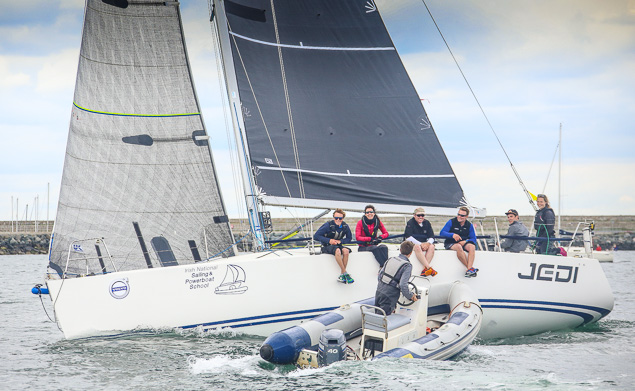 Just back from a top showing at the Rolex Fastnet Race, Kenny Rumball's Jedi from the Irish National Sailing School competed in ISORA's night race and won Class One Photo: Afloat.ie
Just back from a top showing at the Rolex Fastnet Race, Kenny Rumball's Jedi from the Irish National Sailing School competed in ISORA's night race and won Class One Photo: Afloat.ie
The next leg was a loose fetch / tight reach down to Killiney Bay. The fleet had split at this stage. “Aurelia” had passed “Another Adventure” to round that mark first. Close behind the leaders was Kenneth Rumball’s “Jedi” of the INSS and Roger Smith’s “Wakey Wakey” and Vincent Farrell’s “Tsunami”.
 18–boats came to the start line for the ISORA night race along the Dublin and Wicklow coast
18–boats came to the start line for the ISORA night race along the Dublin and Wicklow coast
The next long leg south to Breeches was another broad reach but this time those boats who ventured to hoist spinnakers broke away from the fleet, despite the many broaches. Rounding Breeches Buoy, “Aurelia” still was maintaining its lead just ahead of “Another Adventure”.
The following leg was a fetch north to South Burford. “Aurelia” had by this time extended its lead from “Another Adventure” followed by “Jedi”, Colm Buckley’s “Indian”, “Tsunami” and Paul Egan’s “Platinum Blonde”.
The last leg to the finish was a beat. “Aurelia” continued to extend his lead and took Line Honours, IRC Overall and IRC Class 0. “Jedi” just pipped “Another Adventure” by 26 seconds to take 2nd IRC Overall and IRC Class 1. Derek Dillon’s “Big Deal” took IRC Class 2.
In ECHO, Jim Schofield’s “Thisbe” took Overall and Class 2. “Aurelia” took Class 0 while “Jedi” took Class 1. Full results can be found here
The next race takes place next Saturday, 26th August, a day race from Dun Laoghaire to Greystones. This is one feeder race to the Greystones Regatta to take place the following day. A fleet of 25 boats from a list of 33 entries are expected to make their way to the start line.
 J109 Mojito holds a narrow lead in the overall Avery Crest Offshore Championship going into the Dun Laoghaire–Greystones race this weekend. Photo: Afloat.ie
J109 Mojito holds a narrow lead in the overall Avery Crest Offshore Championship going into the Dun Laoghaire–Greystones race this weekend. Photo: Afloat.ie
The Overall Avery Crest Offshore Championship is hotting up with “Mojito” slightly ahead of the current Champion “Sgrech” and followed closely by “Jedi” and “Aurelia”. With a large fleet expected for the last offshore from Pwllheli to Dun Laoghaire on the 9th September, it is possible for any one of those boats to snatch the coveted “Wolf’s Head” trophy.
Battle of Dun Laoghaire Harbour Fought By INSS Viking Invaders
Out of the mist and rain came waterborne Vikings to battle on Dun Laoghaire's East Pier yesterday afternoon. The Irish National Sailing School (INSS) co-ordinated a free and family–friendly event that featured battles, longboats and a Viking village from 12-5pm.
Like a thousand years ago, the marauding did not commence on time. Downpours, however, did not deter an impressive crowd of hundreds, huddled together at the town's bandstand. By battle–time there was a steady stream of people on the pier's top level. Some locals even took it upon themselves to intercourse with invaders. Others were more focussed on the fight.
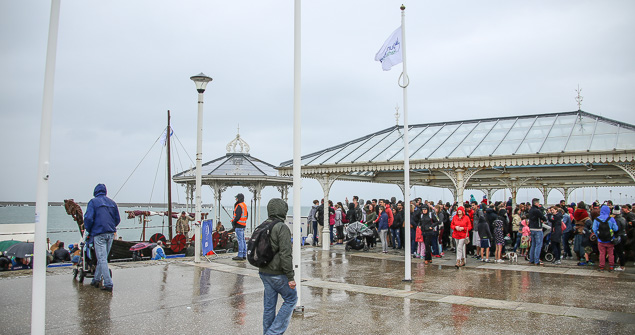 Local forces take shelter Photo: Afloat.ie
Local forces take shelter Photo: Afloat.ie
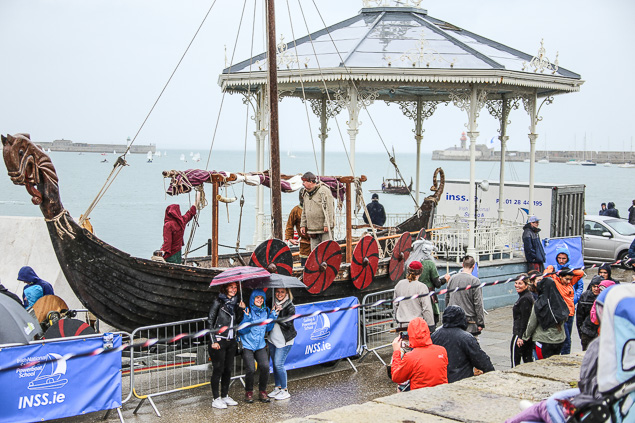 Taking time for some Viking selfies before battle commences Photo: Afloat.ie
Taking time for some Viking selfies before battle commences Photo: Afloat.ie
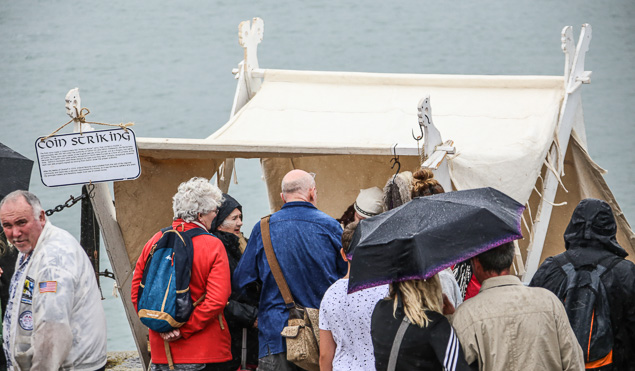 The Norsemen soon set up shop Photo: Afloat.ie
The Norsemen soon set up shop Photo: Afloat.ie
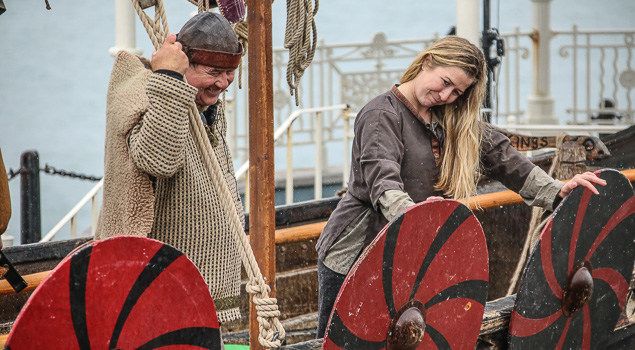 Some were friendly....Photo: Afloat.ie
Some were friendly....Photo: Afloat.ie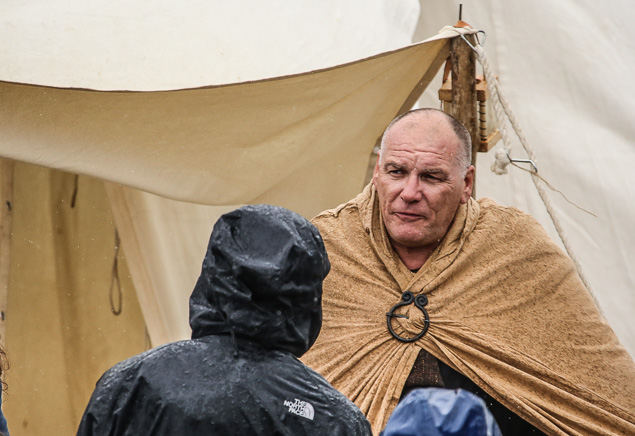 others maybe not so much...Photo: Afloat.ie
others maybe not so much...Photo: Afloat.ie
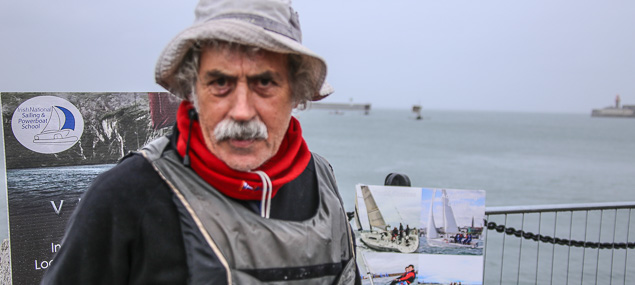 INSS's Alistair Rumball prepares for battle as Viking longships approach from the harbour mouth Photo: Afloat.ie
INSS's Alistair Rumball prepares for battle as Viking longships approach from the harbour mouth Photo: Afloat.ie
INSS's Alistair Rumball, who provides Marine Film Location Services to the hit TV series Vikings, has been blamed for the Norse incursion.
His unlikely alliance with harbour forces including, King of Dun Laoghaire Harbour Gerry Dunne, led to the pitting of seafarers versus townspeople on the occasion of the harbour's bicentenary.
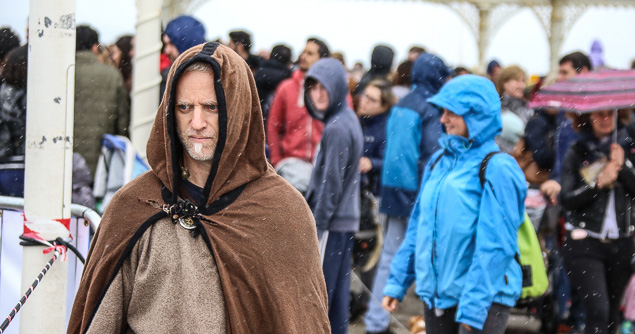 The Irish summer was no deterrent to the planned invasion Photo: Afloat.ie
The Irish summer was no deterrent to the planned invasion Photo: Afloat.ie
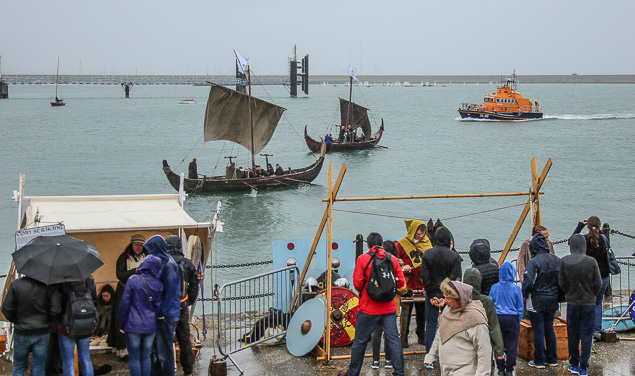 Not even the local lifeboat could stop it...Photo: Afloat.ie
Not even the local lifeboat could stop it...Photo: Afloat.ie
The onset of bad weather though, meant the Vikings, who approached under oar and sail, arrived early at the harbour mouth (Battle of Clontarf, here we go again) and Chief Rumball decreed battle should commence by 2pm.
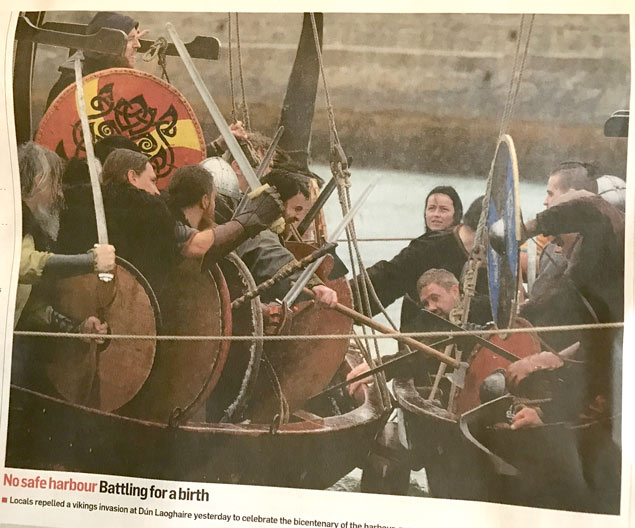 Making the press: Dun Laoghaire's Viking battle hit the headlines, including this fine photograph in this morning's Irish Times
Making the press: Dun Laoghaire's Viking battle hit the headlines, including this fine photograph in this morning's Irish Times
The battle was shorter than in Clontarf's sunrise to sunset exaggerated affair, but ended all the same in a rout of the Leinster forces that was witnessed by the High Chief of Leinster, Mary Mitchell O'Connor TD, Minister of State at the Department of Education.
The Viking contingent led by Sigurd Stena Line of Orkney and Brodir Irish Ferries of Mann were soon back in charge of the Piers – to the relief of many.
Sailing School Offshore Entry Are Runners–Up in Dun Laoghaire Regatta's Biggest Class
Skipper Kenny Rumball and the INSS crew celebrated a fine second overall in a fleet of 32–boats, the biggest division of the 2017 Volvo Dun Laoghaire Regatta. The J109 crew on Jedi were only five points off the top spot, taken by Howth's Flashback, after a tricky series of four coastal races in which the sailing school students finished second twice.
The INSS scored 12, 2, 2 and a 9 on the final day over courses that saw the impressive offshore fleet race out to the North Burford buoy on Dublin Bay and as far south as Bray, County Wicklow in mainly light winds and some strong tides.
Offshore success is nothing new for the INSS who are regular offshore competitors in ISORA. Last year, Rumball scored tenth overall in the 63–boat, 2016 Round Ireland race, again with sailing students as crew.
Learn From An Expert On INSS South East Summer Cruises
#Cruising - Leisurely cruising isn’t all that’s on the agenda when the Irish National Sailing & Powerboat School’s Elan 36, Beaufort Venture, sails the South East Coast this July.
INSS cruising instructor Gary Curran will lead each cruise in a series of mile-building passages, giving expert guidance to help you practice the skills you need for your own yachting and cruising programmes.
Places are still available on two of the five cruises (€560 each, travel and meals not included) which promise to include everything you will find in the INSS’s standard Competent Crew or Day Skipper courses.
Cork to Castletownbere to Schull from 6-10 July and the return journey from 12-16 July are both five-day cruises. Book quickly to avoid disappointment via the INSS website HERE.
INSS Welcomes Tall Ship Phoenix to Dun Laoghaire Harbour
The Irish National Sailing School (INSS) welcomed their old friends on the Tall Ship Phoenix back to Dun Laoghaire Harbour today.
The Phoenix, operated by film production facility Square Sail, participated in last weekend's Dublin Port Riverfest on the River Liffey.
The two–masted brig is currently along side at the West Pier in Dun Laoghaire for maintenance work to bottom timbers.
'It's 20 years exactly since INSS and Square Sail worked together on the D–Day beach scenes on the film 'Saving Private Ryan' in Wexford', INSS's Alistair Rumball told Afloat.ie
INSS provide marine production faciliies in Ireland and Rumball is currently working on the TV smash–hit The Vikings, as Afloat.ie previously reported.
Children’s Summer Sailing Courses With The INSS
#TrySailing - Summer sailing courses for children aged 4 to 17 are available to book now at the Irish National Sailing & Powerboat School in Dun Laoghaire.
The 2017 summer courses, which begin next Tuesday 6 June, will see students assigned to groups according to their age (4-6 years, 7-10 years, 11-14 years and 15-18 years) and experience.
All essential gear is provided, from boats to buoyancy aids, while wetsuits can be hired by the week.
This year sees two new programmes running alongside the summer sailing courses: sailing through the Irish language for 11-14-year-olds and a keelboat programme providing a different challenge for teens 15 and over.
Click HERE for full details of the INSS summer sailing course programme and how to book.
#TrySailing - Sunday 14 May is the date for the Irish National Sailing & Powerboat School’s 2017 Open Day — where anyone can try sailing, kayaking or paddleboarding at Dun Laoghaire Harbour for only €10.
All ages are welcome on the day, whether families, friends or individuals, for what promises to be an exciting day on the water — coinciding with the annual Sail-a-thon charity event organised by sailors attending the INSS junior club sailing programme.
Whether you’re entirely new to the sport or rekindling an old flame, you’ll be learning how to sail on board one of the school’s fleet of 1720 sportsyachts — waterproof overalls and lifejackets provided!
Those interested in kayaking and paddleboarding, meanwhile, will be guided around the sheltered waters inside Dun Laoghaire Harbour to give a taste of what makes these activities so appealing.
Details on booking a session for the day can be found on the INSS website HERE.



























